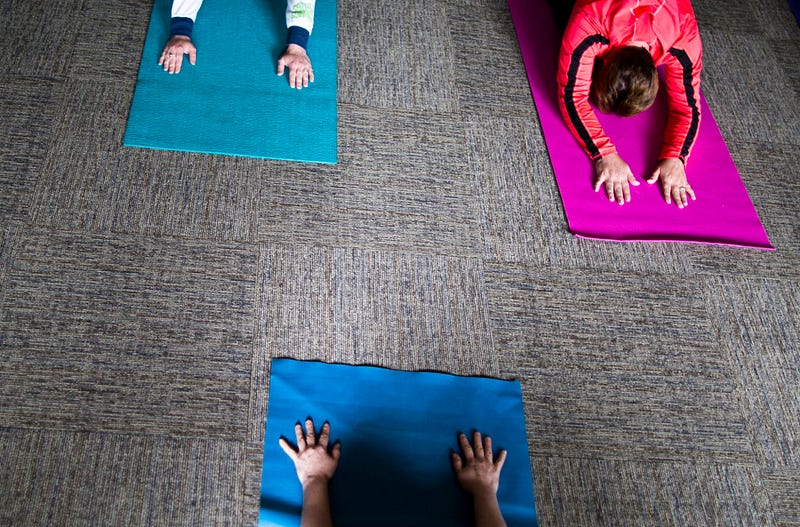On the Mat
Yoga practice provides Multiple Sclerosis relief
STORY BY JAMES HEARNE, PHOTOS BY NICK DANIELSON
In a back room of Christ the Servant Lutheran Church, yoga instructor Abby Staten leads her students through child’s pose during a morning class on May 22, 2015. The class is focused on helping those with multiple sclerosis combat the currently incurable disease. Nick Danielson / Klipsun Magazine
No one sees multiple sclerosis coming. It is sneaky, covert and mocks any attempts at predictability or control.“The only predictable thing about MS is that it’s unpredictable,” I read on support sites for sufferers shortly after my diagnosis. This mantra, meant to be encouraging, may quickly become a taunt. I can no longer reliably control my body the way I used to. A walk once performed with ease now requires frequent rests. I am acutely aware of every step I take. No cure exists for MS. Those who are diagnosed live with it for the rest of their lives. The only sure relief is death. Anything that supports regained sense of control is a comfort. Medication helps, while yoga provides momentary liberation.
A small room in Christ the Servant Lutheran Church is covered in yoga mats on a cloudless Friday in Bellingham.
Most of the owners appear to be over age 60.

They are mostly women, except for myself and another man. Each of us comes from a different background, has various beliefs and experiences diverse ways of living, but there is one commonality amongst the group.
We all have multiple sclerosis.
Abby Staten leads our class by offering many self-care exercises that make MS more bearable.
We are first led through what is referred to as a self-massage. Here, a tennis ball is rolled along the sole of a bare foot. The purpose of this exercise becomes clear as the numbness and tingling in the foot — one of the hallmarks of MS — seems to lift for a short while.
Similar exercises include stretching movements of the legs and arms. As one of the symptoms of MS is difficulty with balance, there are rarely any unmoving poses.
“It’s important for people with MS try to move as much as possible,” Staten says. “Yoga is particularly ideal for that.”
Staten mentions the mind-body connection as one of the main benefits of yoga.
She talks about the idea of proprioception, which is the cognitive function of how the body knows where it is in space. With MS, this function slowly breaks down.
“The more you are conscious of where your body is, the more you will be able to continue to use it,” Staten says.
One of the other students asks me how I am doing as the class begins to warm up.
I recognize what she is asking. This is no “How’s your day?” or “How ‘bout those Mariners?” sort of greeting. What she is asking is how I’m grappling with my condition, the one that brought us all here, together.
“I’m coping,” I say, trying to keep casual. “You know, still standing.”
The room chuckles with an undercurrent of understanding. The student smiles intuitively at me.
“We all are,” she says.
